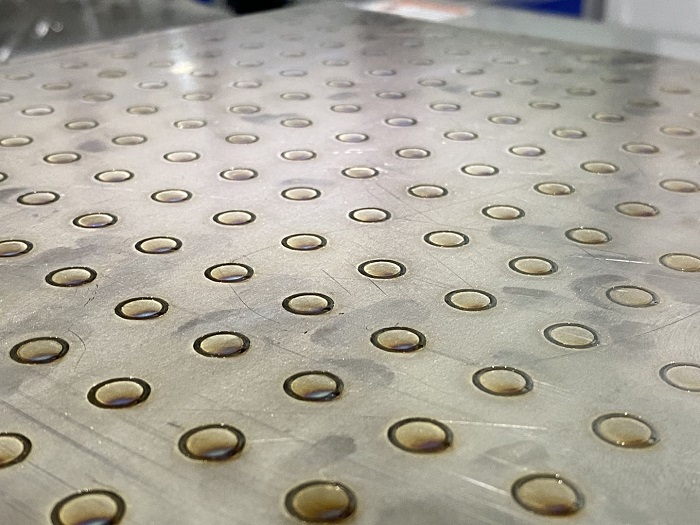The pillow plate consists of two stainless steel sheets that laser welded together by automatic laser welding
system a custom circle weld pattern.Such as 0.5mm to 1.2mm thickness stainless steel of pillow plate weld
3mm to 5mm stainless steel of bottom together that consist complete pillow plate heat exchanger.The outside
perimeter of the pillow plate is fully laser welded to create a pressure boundary. At the edges of the pillow plate,
a contour is welded to create a pressure-tight part.The pillow plate is hydraulically inflated by using water through
a hydrostatic pump. Hydraulically inflating will guarantee for a safe inflation process. Other inflation processes can
be used depending on the application. The inflation process pressurizes the two sheets which allows the material to
deform, a cavity will be created for use of a heat transfer medium. The pillow plate can be used with either liquids,
steam or refrigerants.The application of pillow plates is very extensive,like keep material usually fluids and gasses
hot or cold. This is principle is both commomn and widely used.Heat sinks in electronic industry which transfer
heat from the electronic components to the surrounding air are heat exchangers, as are the radiators in vehicles,
which used a special fluid to cool the engine to keep it from overheating and warpping the metal engine part.



Industrail dairies
The most common application for pillow plate heat exchangers is in industrial dairy operations. Milk is warm when
produced and keep on hot when pasteurized,but it need to refrigerated then on pillow plate heat exchangers facilitate
both quick temperature changes and mantain long term cooling to keep dairy products at stable,consistent temperature.
Fluid flow and heat transfer in pillow plates (inner channels)
The complex wavy geometry in pillow plate channels promotes fluid mixing, which leads to favorable heat transfer rates
but is also unfavorable for pressure loss (formation of recirculation regions in the wake of welding spots). Information on
fluid flow and heat transfer in pillow plates is available in, while correlations for the calculation of Darcy-Friction-Factor
and Nusselt number in pillow plates over a wide range of geometrical parameters variations and process conditions is
found in. Fluid flow and heat transfer in the gap between adjacent pillow plates (outer channels)
Similar to the inner channels of pillow plates, the channels formed between adjacent pillow plates (outer channels) are
also wavy and promote fluid mixing, which is in turn favorable for heat transfer rates. However, pressure loss in the outer
channels is significantly lower than in the inner ones because of the absence of welding spots, which act as obstacles for
the flow (flow around welding spots). Information on fluid flow and heat transfer in the outer channels of pillow plate
heat exchangers is available in
Falling film flow over the surface of pillow plates
The reliable design of condensers, falling film evaporators and water chillers requires detailed knowledge of fluid
dynamics and heat transfer of the falling liquid film over the surface of the pillow plates. First insights on flow
phenomena of the falling liquid film are available in
|
Product Name
|
Pillow Plate | Thickness of two sheets | Double embossed plates | Single embossed plates |
| Material | Stainless Steel | 0.8mm+0.8mm | 0.8 mm + 2.0 mm base plate | |
| Color | Nickel White | 1.0mm+1.0mm | 1.0 mm + 2.5 mm base plate | |
| Standard | DIN GB ISO JIS BA ANSI ASMI | 1.2mm+1.2mm | 1.2 mm + 4.0 tot 15 mm base plate | |
| Grade | SUS201,SUS304,SUS316,TA2, | 1.5mm+1.5mm | 1.5 mm + 4.0 tot 15mm base plate | |
| Hastelloy | ||||
| Brade | Hanpu | 2.0mm+2.0mm | ||
| Length | Max.12000mm | |||
| Width | Max.2000mm |
Here are video of different way to weld pillow plate heat exchanger by automated fiber laser welding machine
- Cost-effective way,cnc fiber laser welding machine with manual clamp two pieces stanless steel fixed together
after start weld by laser welding machine, when pillow plate heat exchangers finished welded after unloading it manual.
-Automated clamp device with loading and unloading automated fiber laser welding machine system.
a)Robotic automated fiber laser welding machine with scanner head weld system.
b)CNC automated clamp device with loading and unlaoding laser welding machine system.
By continuing to use the site you agree to our privacy policy Terms and Conditions.